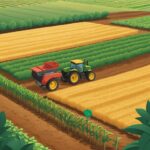Physical address:
5501 Stockdale HWY #9442
Bakersfield, CA 93389

Course 5: Agricultural Meteorology
Agricultural Meteorology explores the relationship between weather, climate, and agricultural practices. This course provides students with a comprehensive understanding of how weather patterns, atmospheric conditions, and climate change impact crop growth and agricultural productivity. It emphasizes techniques for monitoring and forecasting weather to optimize agricultural operations and minimize risks.
Curriculum
- 6 Sections
- 14 Lessons
- 1 Quiz
- 0m Duration
Section 1: Introduction to Agricultural Meteorology
2 Lessons
- Chapter 1: Overview of Agricultural Meteorology
- Chapter 2: Atmosphere and Weather Systems
Section 2: Weather Elements and Crop Growth
3 Lessons
- Chapter 3: Temperature and Its Effect on Agriculture
- Chapter 4: Precipitation and Rainfall Patterns
- Chapter 5: Humidity, Wind, and Evapotranspiration
Section 3: Weather Forecasting and Agricultural Planning
2 Lessons
- Chapter 6: Weather Forecasting Tools for Agriculture
- Chapter 7: Application of Weather Forecasts in Farming
Section 4: Climate Change and Agriculture
2 Lessons
- Chapter 8: Understanding Climate Change
- Chapter 9: Adaptation Strategies for Climate-Resilient Agriculture
Section 5: Practical Applications of Agricultural Meteorology
2 Lessons
- Chapter 10: Microclimates and Precision Agriculture
- Chapter 11: Weather-Related Risk Management
Assignments and Assessments
3 Lessons1 Quiz
- Assignment 1: Analyze historical weather data for a selected region and predict its impact on crop yield.
- Assignment 2: Develop a crop calendar based on a 10-day weather forecast.
- Quiz: Test on weather elements and their influence on crop growth.
- Final Project: Create a climate-resilient farm plan incorporating weather forecasts and risk management strategies.



